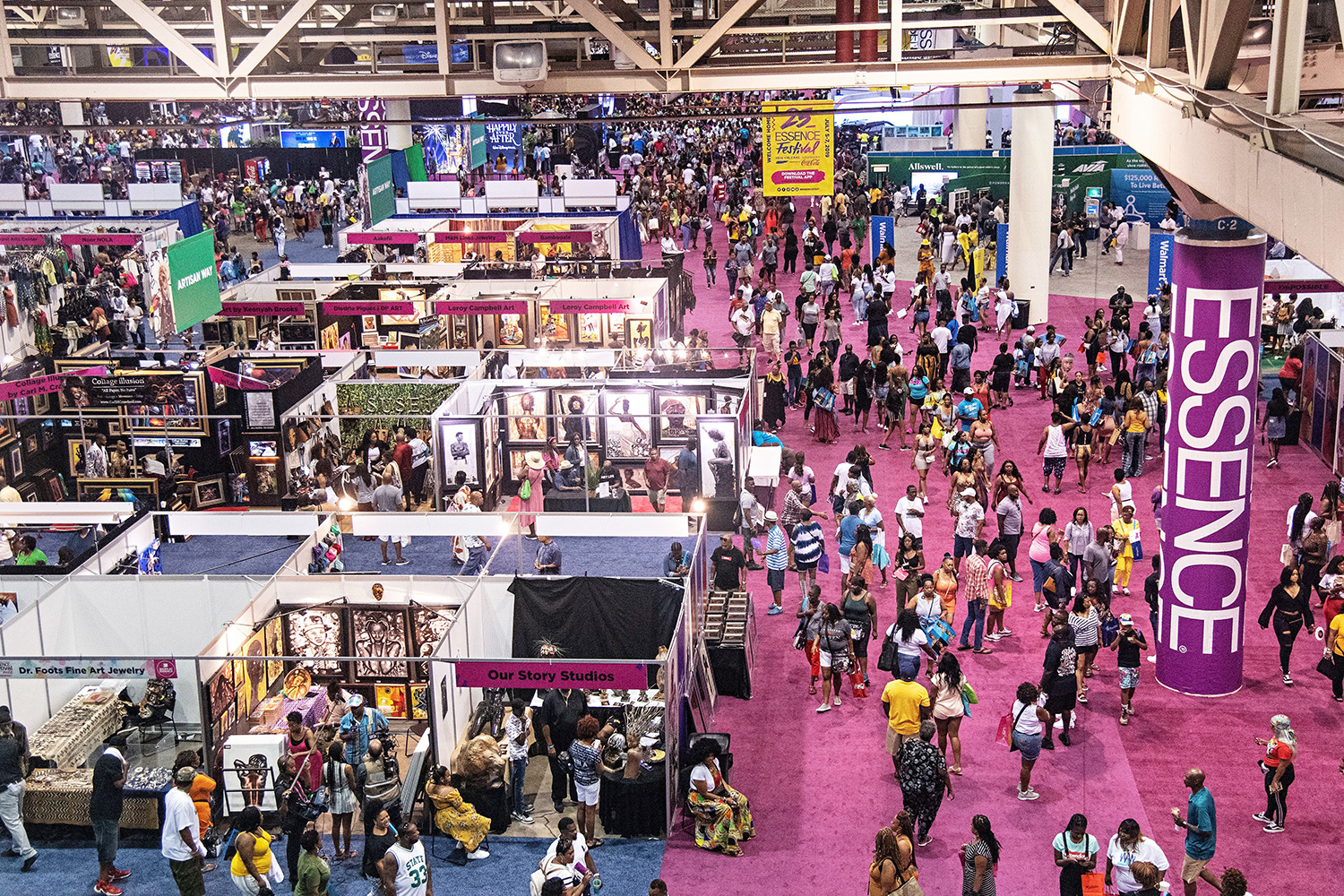Since its start in 1995, Essence Festival has brought millions of people to New Orleans during the Fourth of July weekend when it is held. Originally meant to be a one-time event to celebrate the 25th anniversary of Essence Magazine, the Essence Festival has become the largest African-American annual music event in the United States. Geared towards African-American women, Essence is a lifestyle, fashion, and beauty brand that features depictions and perspectives of Black women that are not always included in white magazines. With Essence Magazine’s monthly circulation of over a million and readership of 8.5 million, it is no surprise that the most recent Essence Festival in 2019 drew in over 500,000 visitors– surpassing the attendance of New Orleans’ Jazz and Heritage Festival, which is a week-long in comparison to Essence’s three days.

2019 Essence Festival, Photo by Amy Harris/Invision/AP/Shutterstock
Despite bringing in many tourists and lots of business during what is colloquially known as New Orleans’ “low season,” or the lull in tourism from June to September, in the past, restaurant closures during the Essence weekend have sparked frustration over the lack of hospitality afforded to Black tourists. In 2013, the hashtag #ClosedForEssence began in order to draw attention to the strange and potentially racially biased motivations for restaurants not being open during Essence Fest. However, it wasn’t until three years later, in 2016, that the hashtag went viral. Popular restaurants, including Walk On’s Bistreaux and Bar New Orleans, Domenica, One Eyed Jacks, and Little Gem Saloon, came under fire for announcing their temporary closures. Walk On’s posted a sign on their door stating they would be “closed from 6/29/2016 @ 3PM – 7/6/2016 due to repairs,” while Domenica announced that they would be “closed for renovations starting on Monday, June 27th and reopening Wednesday, July 6th” on their Facebook page. Each of these restaurants is located either in the French Quarter or within walking distance of the Mercedes Benz Superdome, where the festival is located. Many Facebook and Twitter users questioned these excuses while using #ClosedForEssence, wondering why a restaurant would choose to close during one of the largest tourism weekends of the year. One user, Malik Bartholemew, noted on Walk On’s Facebook page that “the only difference with this weekend and other big weekends is that the majority of the city visitors will be African-American.”
Many of the named businesses responded to accusations claiming that their excuses were legit. Still, whether one chooses to believe them or not, the controversy speaks to a much more deep-seated issue regarding the historical treatment of the Black community in New Orleans’ tourism industry. New Orleans’s reputation as a “party city” has been around since the early 20th century. Much of this reputation has grown from Black cultural influences– in the French Quarter, jazz music floods the streets, restaurants feature Creole and Black regional cuisine, and gift shops sell Voodoo novelties. However, while the tourism industry in New Orleans brought in over 10 billion dollars in 2019, a 2015 report found that the bulk of the city’s tourism workers hold low-wage jobs, making less than $15 an hour. These jobs are held disproportionately by Black people, who account for 68% of housekeepers, 55% of desk clerks, 56% of cooks, 56% of hotel janitors, and 55% of dishwashers in New Orleans. Each year, the city puts about $200 million in tax revenue towards tourism, and while the Black community helped shape the tourism industry, over half of all Black families in New Orleans made less than $25,000 in 2018.
Despite this systematized celebration of Black culture in the tourism industry, Black tourists have long faced discrimination, and not only in New Orleans. In 1936, Victor Hugo Green published the first “Green Book,” a guide for Black travelers primarily in the South that listed areas, hotels, and restaurants where Black tourists would be safe. At the time, Jim Crow laws that made a racial caste system legal left Black travelers susceptible to being harassed, attacked, or even fatally assaulted. While Jim Crow laws were undone on paper in the 1960s, the lasting stereotypes and potential dangers of traveling remain relevant for many Black tourists.
One stereotype that remains prevalent today is that Black customers are seen as bad tippers. A 2015 survey of 1000 restaurant servers found that 34% thought that black diners were “very bad” tippers, an additional 36% believed that Black diners were “below average” tippers, while 98% said that white diners were “average” or “above average” tippers. During the weekend of Essence Fest, while some restaurants closed, another trend noticed and pointed out on Twitter was that some restaurants that remained open imposed an automatic 20% tip on customers. While some studies find that Black diners do tip slightly less on average than white diners, this difference can be linked to Black customers receiving relatively worse service in restaurants. An anonymous restaurant owner in New Orleans said that he would have staff that won’t show up during predominantly Black events like Essence because of the belief that certain ethnicities don’t like to tip. People in the restaurant industry who alter operations based on whether their patrons are stereotypically seen as good customers or not may be trying to act economically wise, but it has resulted in an environment that doesn’t feel hospitable to everyone.
 NOLAbeings
Multimedia artist Claire Bangser created NOLAbeings as a portrait-based story project that marries...
NOLAbeings
Multimedia artist Claire Bangser created NOLAbeings as a portrait-based story project that marries...
 Data corner: Adobe Suite (create a PDF, social media graphic, presentation, edit a photo and video
Data corner is where you go to work with analytics and top tech skills. It takes on everything from PERL and SQL to Canva and Sprout Social.
Data corner: Adobe Suite (create a PDF, social media graphic, presentation, edit a photo and video
Data corner is where you go to work with analytics and top tech skills. It takes on everything from PERL and SQL to Canva and Sprout Social.
